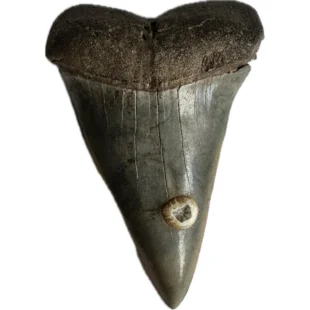Fossil Shark Teeth Fun Facts
- Are Fossil Shark Teeth Real?
Yes, fossil shark teeth are real remnants from ancient sharks that lived millions of years ago. These teeth are the most commonly found fossils of sharks and provide insight into prehistoric marine life. Fossils of shark teeth have been discovered around the world, confirming the existence of many different species of sharks throughout Earth’s history. These fossils are valuable for paleontologists and collectors, as they offer a direct link to the ancient oceans and the creatures that once inhabited them. - How Big Were Ancient Shark Teeth?
Shark teeth varied in size depending on the species. Some species, like the Megalodon, had teeth that could reach over 7 inches long, while smaller shark species had teeth only a few millimeters in size. Fossil shark teeth can be found in a variety of sizes, with the largest ones coming from extinct giants like the Megalodon or Carcharocles angustidens. The size and shape of these teeth often depended on the shark’s diet and hunting style, which ranged from feeding on small fish to large marine mammals. - What Did Sharks Eat?
Sharks are apex predators and had a wide-ranging diet depending on the species. Ancient sharks fed on fish, squid, sea turtles, and larger prey, including marine mammals. Fossil shark teeth reveal much about the diet of prehistoric sharks, as the teeth are designed for tearing and cutting. For example, sharks like the Megalodon likely fed on large whales, while smaller species hunted schools of fish and smaller creatures. The shape of the teeth also helps scientists determine the feeding habits of various species of sharks. - Why Are Fossil Shark Teeth So Valuable?
Fossil shark teeth are highly valuable for collectors and paleontologists due to their rarity and historical significance. Since sharks constantly shed teeth throughout their lifetimes, many fossilized teeth have been preserved and can be found in marine fossil beds. Shark teeth are considered valuable because they are often well-preserved and come in a variety of shapes and sizes, depending on the species. These fossils offer a glimpse into ancient marine ecosystems and can fetch high prices in the fossil market, especially when they are from rare or extinct shark species. - Where Is the Best Place to Find Fossil Shark Teeth?
Fossil shark teeth can be found in many parts of the world, with some of the best-known locations being the southeastern United States, particularly in Florida and South Carolina. These areas are rich in marine fossils, and the erosion of ancient seabeds has exposed shark teeth that have been preserved for millions of years. Other prime locations for finding shark teeth include the beaches of the Bahamas, parts of Africa, and some regions in Europe and Australia. Fossil hunters often seek out these locations for the chance to uncover rare and well-preserved shark teeth.
Prehistoric 101 (Learn about fossils, minerals, and meteorites)



